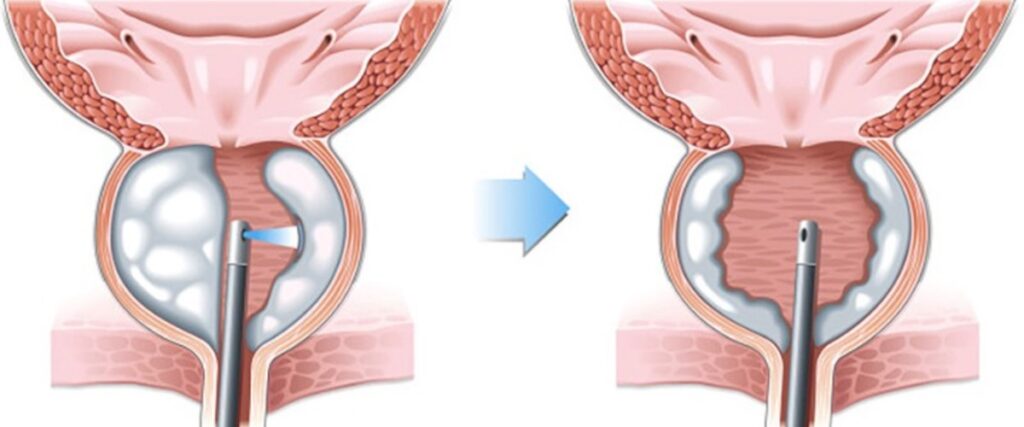
HOLEP
Known as Holimium Laser Prostate Enucleation HOLEPIt is a surgical method using advanced laser technology in the treatment of benign prostate enlargement. Today, it is considered the gold standard treatment. Prostate Enucleation with Holimium Laser, It is a closed procedure that can clean and remove all prostate tissue.
It is used effectively in the treatment of prostate enlargements of all sizes. Prostate Enucleation with Holimium Laser treatment is frequently preferred in prostate treatment today. Prostate Enucleation with Holimium LaserIt is also considered the gold standard treatment method. It is mostly performed with general anesthesia or anesthesia from the waist down. HoLEP treatment, the foundations of which were laid in 1995; It has taken its final form today. The treatment method is comfortable and reliable for both the patient and the surgeons.

What is Holep Treatment?
Prostate Enucleation with Holimium Laser Treatment is a frequently applied technique in benign prostate enlargement. Today, it is one of the most modern methods that allows achieving successful results in prostate diseases. In this method, some parts are removed with the laser. It has also been observed that it can be applied to all prostate sizes. Therefore, this type of treatment is performed regardless of prostate size.
In this method, which is performed using Holmium laser, the inner prostate tissue is removed. If the patient does not improve with drug treatment, this method is used. Moreover Prostate Enucleation with Holimium Laser One of the advantages of the treatment is that it has a low risk of bleeding. After the procedure, the patient's hospital stay is quite short. The patient shows improvement in as little as 24 hours after the treatment.
HoLEP treatment; It is applied to patients who complain of benign prostate enlargement and whose complaints significantly reduce their quality of life. Enables the removal of all prostate tissue by closed method Prostate Enucleation with Holimium Laser treatment; It is very advantageous considering patient comfort and complications that may occur during the procedure.
Prostate Enucleation with Holimium Laser Situations where the method should be used;
- If there is no benefit from drug treatment,
- If you have kidney dysfunction,
- If a catheter is needed during urination,
- If an excessive amount of urine remains in the bladder after urination,
- If there is an infection that does not go away and recurs frequently,
- If frequent bleeding and stones occur,
While the above complaints affect the daily life of the patient, frequent recurrence of complaints such as infection and bleeding can weaken the immune system. In such cases, if the urologist deems it appropriate, Prostate Enucleation with Holimium Laser treatment can be used.

How is HoLEP Surgery Performed?
Performed under general anesthesia or anesthesia from the waist down HOLEP During the surgery, the urinary tract is entered with special instruments equipped with cameras. The growing prostate tissue is separated from the capsule with the help of laser and thrown into the bladder. The prostate tissue thrown into the bladder is broken down, vacuumed and thrown out of the body. The surgery is then completed by inserting a catheter into the patient. Prostate tissue removed from the patient is sent to pathology for cancer research.
What are the advantages of HoLEP Surgery?
It is effectively used in the treatment of prostate enlargements of all sizes. Prostate Enucleation with Holimium Laser It is frequently preferred by both physicians and patients due to the advantages it provides. Prostate Enucleation with Holimium Laser The advantages of the surgery can be listed as follows;
- The procedure is performed without the need for any incision, even in very large prostates.
- It is an alternative method to open surgery,
- The probability of the patient needing re-operation after surgery is very low,
- The risk of bleeding during surgery is very low,
- The patient's postoperative hospital stay is usually 1 to 2 days.
- Patients whose catheter is removed after surgery do not experience a burning sensation.

Who Can Have HoLEP Surgery?
The HoLEP technique, which is a suitable method for anyone who requires prostate surgery, is applied successfully, especially in large prostates. It can be applied to patients with cardiovascular disease, patients who have undergone bypass, and patients who use blood thinners due to vascular occlusion. The patient's suitability for surgery is determined based on the general examination performed by the physician and the results of the necessary tests requested by the physician.
What Should the Patient Pay Attention to After HoLEP Surgery?
After HoLEP surgery, which is among the surgeries with high success rates, the patient is discharged within 1 to 2 days. The discharged patient can return to daily activities within a few days. HOLEP The surgery has a very comfortable and fast recovery process. For the sake of the patient's health, it is necessary to wait 2 - 4 weeks before doing heavy work and sports activities, as is the case after every surgical operation.
Prostate Enucleation with Holimium Laser Sexual Life After Surgery
Applied in the treatment of benign prostatic hyperplasia Prostate Enucleation with Holimium Laser After the patient is discharged after the technique, he/she must stay away from sexual activity for the period specified by the physician. Although this period varies, it is generally 2 - 3 weeks.
Frequently Asked Questions
The HoLEP method is a closed procedure that can clean and remove all prostate tissue. It provides similar results to open surgery in large prostates.
The HoLEP method has a very fast and comfortable recovery process. Patients can return to their daily activities within a few days after surgery.
The HoLEP method can be applied to all patients with benign prostate enlargement who require surgical intervention.
Our treatments
- Prostate cancer
- Bladder Cancer
- Kidney Cancer
- Kidney stone
- Robotic Surgery
- HOLEP
- ThuLEP
- Prostate Biopsy
- hydrocele
- varicocele
- Testicular Cancer
- Urinary tract infection
- Urinary Incontinence in Women
- Urodynamics
- Vesicovaginal Fistula
- Laparoscopy Surgery
- Sacral Neuromodulation
- Laser Prostate Surgery
- Penile Prosthesis Implantation
- Prostate Hot Water Steam Treatment
- Penile Shock Wave Therapy – ESWT
- Male Infertility
- Drug Treatment for Sexual Dysfunction (Erectile Dysfunction)
